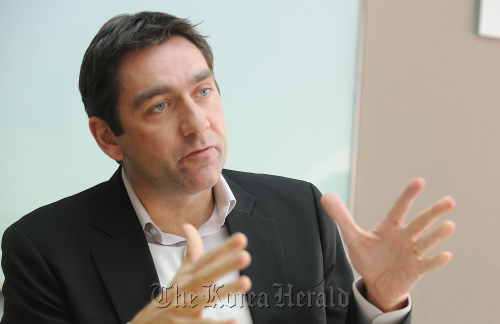With the mainstay of Asia’s fourth-largest economy shifting from smokestack industries to high-tech, Korea became one of Maersk’s five key markets along with China, the U.S., Germany and India.
An upsurge in overseas manufacturing output by new global powerhouses such as Samsung and LG pushes up trading volumes, thus boosting container shipping, he said.
A 20-year veteran, Sorensen joined A.P. Moller-Maersk A/S in 1991. Prior to arriving in Seoul in January, he served the Danish shipping and oil giant in Hong Kong, Beijing, India and Thailand.
One of the industry’s biggest transitions during his career was what he called the “electronic revolution,” which he said transformed the way the company deals with its clients while boosting productivity and transparency.
“If you go back to the 50s and 60s, it took days before you knew what was actually going on. But now it’s instant ― the moment something happens, the customers see it online. That’s something e-commerce is allowing us,” Sorensen said.
“We’re now getting more than 90 percent of transactions between us and our customers online. And I think the figure will only continue to increase.”
However, container lines have been struggling with their balance sheets in recent years as freight rates plunge after the industry threw too many ships into a languishing market.
According to Clarkson Plc, the world’s biggest shipbroker, there were 490 ships through 52 different services on the Asia-Europe route at the end of 2011. Maersk, which claims a 15 percent stake in the Korean market, operates around 100 vessels on the section.
Skyrocketing oil prices, on top of the prolonged European debt crisis, also mean a dismal outlook for an industry that is among the most affected by crude price swings.
Already buffeted by political turmoil in the Middle East, oil prices rally day after day as tensions persist between Iran and the West, with Brent crude for April delivery nearing $124 a barrel in London on Monday.
A.P. Moller-Maersk’s container unit posted a net loss of 2.88 billion kroner ($521 million) last year, compared with a profit of 14.9 billion kroner a year ago.
To shake off high fuel costs and perk up profitability, Maersk is striving to streamline operations and curb fuel consumption by maintaining energy-efficient speed and through new technology.
Last month, the Copenhagen-based group said it will cut 9 percent of its vessel capacity on Asia to Europe, its largest trade route.
The company also said it will jack up the rates for a 20-foot container from Asia to Europe by $775 and a further $400.
“There’s an increase in layups of ships, simply because most shipping lines, with the current rate levels, are losing money,” Sorensen said, adding that freight rates hit an all-time low in December.
“We’re expecting to see rate increases throughout this year.”
Meanwhile, the Daily Maersk, a service launched last year to offer departures every day from key Asian ports to European ones, will help run its ships closer to full, he said. Container lines in general sail on a weekly basis on each service.
Another booster could be the giant Triple-E class vessels, which are being built by Daewoo Shipbuilding & Marine Engineering Co., a Korean shipyard.
At 400 meters long, 59 meters wide and 73 meters high with a 18,000 twenty-foot container capacity, the Triple-E will be the largest vessel of any type, the company said. The first 10 vessels will be delivered 2013 and 2014, and the second 10 are scheduled for delivery in 2014 and 2015.
“(The Triple E ships) are absolutely at the forefront of any kind of technology,” Sorensen said. “We have built a lot of ships in Korea and we’ll continue to do so.”
As for the Korean market, Sorensen estimates a growth rate of 5 percent to 6 percent this year.
“We'll continue to grow in line with the market growth. We don’t expect to go out and significantly increase our market share but we’re looking at where it makes the most sense to maintain the minimum market share,” he said.
By Shin Hyon-hee (
heeshin@heraldcorp.com)








![[Today’s K-pop] Blackpink’s Jennie, Lisa invited to Coachella as solo acts](http://res.heraldm.com/phpwas/restmb_idxmake.php?idx=644&simg=/content/image/2024/11/21/20241121050099_0.jpg)